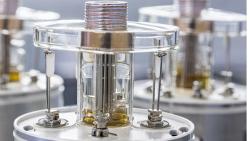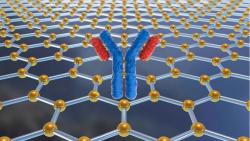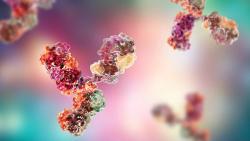
OR WAIT null SECS
- About Us
- Advertise
- Editorial Information
- Contact Us
- Do Not Sell My Personal Information
- Privacy Policy
- Terms and Conditions
© 2024 MJH Life Sciences™ and BioPharm International. All rights reserved.
Selecting Chromatography Resins for Bispecific Antibody Purification
Product and process understanding are essential to effective resin selection.
Targeting enhancement with two active antibody arms makes bispecific antibodies (bsAbs) highly attractive for the treatment of cancer and other diseases. Their purification can be more challenging than traditional monoclonal antibodies (mAbs), however, due to the increased level of product-related impurities with high similarity to the desired bsAbs. Advances in chromatography resins are helping to simplify downstream operations and improve separation performance.
Product-related impurities predominate
In addition to process-related impurities like those seen with mAbs, bsAb manufacturing often results in the production of product-related impurities that can be difficult to separate from the desired product. These impurities, according to Russell Overbeck, director of global technical and CMC at Lonza, largely comprise mispaired variants, including homodimers, halfmers, and others. “Depending on the format of the bispecific, often homodimers, fragments, or half antibodies need to be removed during downstream processing,” agrees Leslie Wolfe, vice-president of process development with KBI Biopharma.
“The biggest challenge for purification of bsAbs, therefore, is separating the target molecule from mispaired variants,” Overbeck states. The difficulty can be enhanced for some bsAbs due to their tendency to aggregate and/or sensitivity to lower pH conditions, which can lead to degradation, misfolding, or other structural changes, comments Eva Heldin, a principal scientist at Cytiva.
On a positive note, Wolfe observes that how a bispecific is designed and/or how the cell line expresses the bsAb can potentially reduce purification challenges. For example, she points out that separation of homodimers with isoelectric points (pIs) different from the heterodimer will be simpler than separation of those with similar charges. Meanwhile, the removal difficulty for half antibodies or other product-related impurities can depend on their levels in the clarified harvest.
Familiar chromatography steps
Purification approaches employed for standard mAbs can often be applied to bsAbs to a certain extent. Processes typically include Protein-A, polishing I, and polishing II chromatography, according to Overbeck. For a given bsAb, he notes that depending on the molecule complexity, pI, and other factors, these steps can look different, but mainly still consist of ion exchange (IEX) and/or hydrophobic interaction chromatography (HIC), and mixed-mode chromatography.
Wolfe says that host-cell proteins and host-cell DNA are typically removed by anion and cation exchange chromatography, while mispaired variant impurities may require an alternative affinity capture resin to remove half antibodies or mixed-mode and/or HIC chromatography to remove homodimers depending on the design of the bsAb.
For Heldin, it is the Protein A capture step that removes most of the host-cell proteins and host-cell DNA. She does observe, however, that often differences in avidity can be imparted to affinity resins that can also provide selectivity for product-related impurities. “We have seen, for instance, that with MabSelect PrismA resin, which possesses both Fc- and VH3-interactions, the avidity effect may be leveraged for an asymmetric bsAb if designed for asymmetry in respect to one of these interactions,” she explains.
A chromatographic step with anion exchanging properties of the resin is almost always included to facilitate good viral clearance and to remove any residual DNA after the capture step, Heldin continues.
High resolution and selectivity are essential
For purification of bsAbs, selectivity over the chromatographic steps is essential, according to Heldin. High resolution is best, adds Overbeck, followed by a combination of high dynamic binding capacity and good pressure/flow characteristics.
“To achieve these goals,” Heldin explains, “the purification process is typically designed with individual steps using orthogonal interaction principles.” She notes that it is important to start with an affinity step that has selectivity for product-related impurities in order to simplify concurrent polishing steps. Furthermore, she says that to achieve a large-scale process with good economy, resins should, in addition to having good pressure/flow properties and good binding capacities, be cleanable between runs to enable several cycles of purification.
Stability is equally important
One key to ensuring good downstream purification performance for bispecifics does not relate to the actual chromatography resins. It has to do with designing stable bsAbs. “Carefully investigating bsAb stability is a good starting point,” states Heldin. Doing so helps determine pH limitations and acceptable salt conditions. That information can in turn be used to select process conditions that ensure good stability of the targeted bsAb, she adds.
As an example, Heldin notes that while the capture step is operated at a neutral pH and is typically straight forward, instability can be observed at elution. In this case, need for instantaneous adjustment to a higher pH may be necessary upon elution. She also notes that “if an HIC-step is found to be more selective than ion-exchange, it may be advantageous to run that step at non-binding or partial-binding conditions to avoid high salt concentrations.”
Product and process knowledge drive resin selection
Understanding the characteristics of a bsAb product as well as the potential impurities that its production process may generate and their properties is necessary for effective chromatographic resin selection.
“When developing a purification process for a bsAb,” Wolfe emphasizes, “it is important to understand the biochemical properties of the product-related impurities that may be present. Specifically, the isoelectric point of the bsAb compared to the potential homodimers is important in selecting not only the resins to screen but also the pH range to evaluate.”
Wolfe goes on to note that depending on the design of the bsAb and product-related impurities present, a specific affinity capture resin may be beneficial to separate half antibodies from the target bsAb. “In these instances, selecting an affinity resin that binds to a region of the bsAb that is not present in the product-related impurities is important,” she remarks.
Similarly, Wolfe notes that understanding the biochemical properties of the product-related impurities that may be present during the polishing step is important for selecting these resins.
The type of bispecific and its intrinsic molecular properties will typically dictate which resin is needed, agrees Overbeck. “Ninety percent of the time, high-resolution cation exchange is effective,” he states. In cases where it is not, he observes that hydrophobic interaction and mixed-mode resins should be screened with high-throughput robotics and scaled-up as appropriate.
Heldin agrees that resins for polishing steps should be screened and stresses that the necessary orthogonality be kept in mind. However, she recommends including a resin with anionic interactions (only anionic or multimodal anionic), and notes the order of the polishing steps can be decided later, always with the goal of minimizing the required buffer adjustments and sample preparation.
Experimental and in silico testing
Screening of chromatography resins for bsAb purification should be achieved, according to various experts, using a combination of physical experimentation and computational modeling.It may, in fact, be necessary to screen for more polishing resins that potentially can provide the selectivity needed for closely related impurities than when working with mAbs, particularly for process developers that have not previously used multimodal resins, according to Heldin.
For instance, according to Wolfe, often product-related impurities have a different surface charge and/or hydrophobicity from the target bsAb. “Through either in silico or experimental characterization of these impurities, one can determine how the target bsAb may differ from the impurities and select resins and operating conditions to screen that will yield the best separation,” she says.
In addition, Wolfe recommends selecting a resin with some level of hydrophobicity, even if the contribution comes from the base bead, to help with development of a robust separation step. She also contends that given the sometimes-challenging separations presented by bsAbs, leveraging multimodal properties on the surface of the bsAb usually results in a more robust separation. Overbeck adds that if a typical high-resolution cation exchange resin does not work, then high-throughput screening using robotics is the best strategy for identifying the best resin.
Of course, screening methods are not effective without good accompanying analytics. “Access to an analytical assay during process development that can distinguish the bsAb product from similar impurities is critical to ensuring a robust separation step,” observes Wolfe.
A few new resin options
New resin chemistries for bsAb purification have focused, not surprisingly, on improving their separation from similar product-related impurities. Some have also focused on providing effective solutions for more sensitive molecules.
Cytiva has introduced several products addressing the first need. “The development of resins with affinity to other domains than the Fc-domain of bsAbs has enabled selectivity towards product-related impurities in the capture step and not just the polishing steps,” Heldin comments.
New products from the company include MabSelect VL, a Protein L-based resin with affinity to the kappa light chain of the monoclonal antibody. “In addition to being useful for capture of fragments, it may also be used to capture a bsAb with high selectivity, especially if the bsAb is asymmetric and contains the kappa light chain on only one of its ‘arms’,” Heldin says.
Cytiva has also introduced MabSelect VH3, a resin with affinity towards the VH3 chain of bsAbs, and Protein Select, a self-cleaving traceless tag and complementary affinity chromatography resin. The latter technology standardizes purification for any protein, rendering it unnecessary to use specific affinity binding partners for each protein, according to Heldin.
As an example of a resin designed to accommodate highly sensitive proteins and antibodies, Overbeck, highlights the Praesto Jetted A50 HipH resin from Purolite as a critical development for the affinity purification of molecules with low pH liabilities.
In the past few years, few truly new resin options have been introduced despite the sharp increase in moluelcular diversity. The next few years will likely see more introductions, which is positive for manufacturing of these more complex therapeutics. In particular, more potential choices leveraging nanofiber-based chemistries are expected.
About the author
Cynthia A. Challener, PhD, is a contributing editor to BioPharm International®.
Article details
BioPharm International
Vol. 37, No. 1
January 2024
Pages: 23-25
Citation
When referring to this article, please cite it as Challener, C.A. Selecting Chromatography Resins for Bispecific Antibody Purification. BioPharm International 2023 37 (1).
Related Content:

 Download Issue: BioPharm International, January 2024
Download Issue: BioPharm International, January 2024

